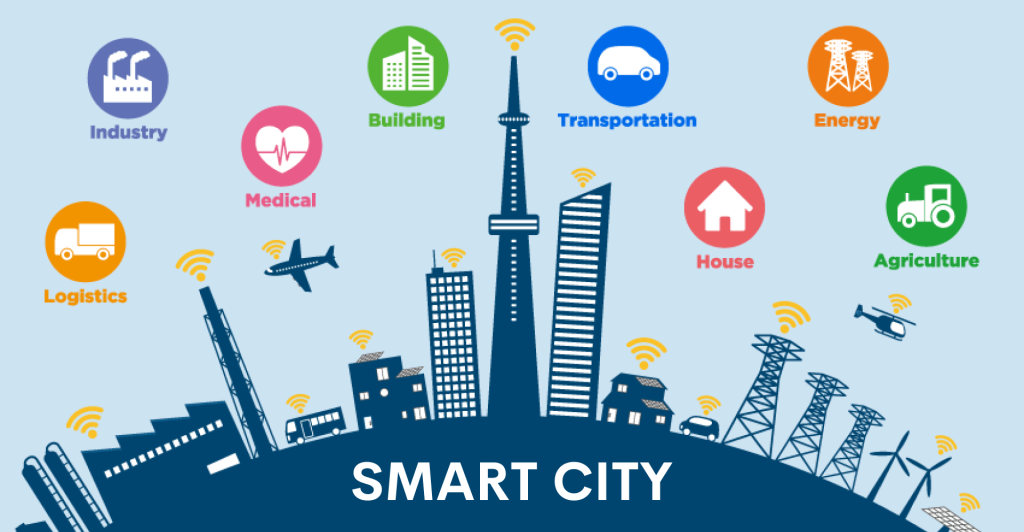The world’s cities are evolving faster than ever before and becoming smart cities. By 2050, nearly 70% of the global population will live in urban areas, according to the United Nations. To handle this growth, cities must become smarter, greener, and more connected. Enter the era of smart cities where artificial intelligence (AI), the Internet of Things (IoT), and sustainable innovation work together to redefine how we live, move, and thrive.
Table of Contents
What Is a Smart City?
A smart city is an urban environment that uses digital technology and data-driven systems to improve the efficiency of services, reduce waste, and enhance citizens’ quality of life. Sensors, connected devices, and AI-powered analytics gather real-time data on everything from traffic flow to energy usage helping city planners make intelligent, responsive decisions.
According to the Smart Cities Council, true smart cities focus on three main goals: efficiency, sustainability, and inclusivity. This means not just smarter buildings or cars, but smarter living for all citizens.
How AI Is Powering Smart Cities
Artificial Intelligence is at the core of every smart city ecosystem. It helps process the vast amount of data generated by sensors, cameras, and devices across the urban landscape turning raw data into actionable insights.
1. Traffic and Mobility Management
AI is revolutionizing urban mobility by optimizing traffic lights, predicting congestion, and improving public transport. For example, IBM’s Watson IoT uses AI algorithms to analyze traffic data in real time, helping cities reduce commute times and fuel consumption.
Autonomous vehicles and intelligent transport systems (ITS) are also transforming urban mobility. Cities like Singapore and Dubai are testing AI-driven public transport and self-driving taxis that adapt to traffic patterns dynamically.
2. Energy Efficiency and Smart Grids
AI-driven energy systems allow cities to balance power demand and supply with precision. Smart grids use predictive analytics to optimize energy flow, reduce waste, and integrate renewable energy sources like solar and wind.
For instance, the European Smart Cities Initiative is implementing AI-powered smart grids that automatically adjust electricity distribution based on real-time consumption patterns reducing emissions and saving costs.
3. Predictive Public Safety
AI is also enhancing public safety by identifying potential threats and assisting emergency responses. Facial recognition, drone surveillance, and predictive policing algorithms help law enforcement anticipate incidents and allocate resources effectively.
However, organizations like the World Economic Forum emphasize that smart city technologies must protect citizens’ privacy and operate under ethical AI frameworks to maintain public trust.
IoT: The Nervous System of Smart Cities
If AI is the brain of a smart city, IoT (Internet of Things) is its nervous system. IoT devices such as sensors, cameras, and smart meters — collect real-time data from the physical world.
- Smart Buildings: IoT-enabled HVAC systems, lighting, and water controls adjust automatically for energy efficiency and comfort.
- Waste Management: Smart bins alert collection services when full, reducing unnecessary trips and fuel usage.
- Water Conservation: IoT water sensors detect leaks and optimize usage, helping cities manage scarce resources sustainably.
According to MIT Technology Review, cities equipped with IoT infrastructure can reduce operational costs by up to 30% while enhancing citizen satisfaction.
Sustainable Urban Living: The Heart of Smart Cities
Beyond technology, the true success of a smart city lies in sustainability. Cities are responsible for more than 70% of global carbon emissions, making eco-friendly innovation a priority.
Green Architecture and Urban Design
Smart cities are embracing green buildings, vertical gardens, and renewable materials to reduce environmental impact. Programs like the LEED Certification and Net-Zero City Initiatives encourage energy-efficient construction.
Renewable Energy Integration
Solar panels, wind turbines, and urban microgrids are becoming standard features of modern infrastructure. AI ensures that renewable energy is distributed efficiently, preventing blackouts and minimizing dependency on fossil fuels.
Smart Mobility and Public Transit
Electric vehicles (EVs), smart charging stations, and AI-optimized transit routes are helping cities cut carbon emissions. For instance, Oslo aims to become the world’s first carbon-neutral city by 2030 through extensive EV adoption and renewable power.
Global Examples of Smart Cities
Several cities worldwide are setting benchmarks in innovation and sustainability:
- Singapore: Uses AI and IoT to manage traffic, water, and waste, ensuring maximum efficiency.
- Barcelona: Integrates smart sensors to control lighting and irrigation systems, saving millions in energy costs.
- Dubai: Employs AI for predictive city planning and autonomous transport under its “Smart Dubai 2030” vision.
- Copenhagen: Combines digital technology with renewable energy to achieve carbon neutrality by 2025.
These examples prove that smart cities are not just about technology they’re about creating human-centered environments that foster well-being and sustainability.
The Challenges Ahead
While smart cities promise a better future, challenges remain. Data privacy, cybersecurity, and the digital divide are major concerns. Without proper regulations, citizens’ personal data could be misused or exposed.
Experts at the Brookings Institution warn that smart city projects must ensure transparency, equitable access, and digital literacy among all residents not just the tech elite.
The Future Vision
The smart cities of the future will be intelligent, adaptive, and human-driven. With the fusion of AI, IoT, and sustainable policies, urban spaces will become cleaner, safer, and more inclusive.
Imagine cities where streetlights dim automatically when no one’s around, buses adjust routes based on real-time demand, and homes produce more energy than they consume.
This isn’t a distant dream it’s a rapidly approaching reality.
Conclusion
Smart cities are the next evolution of urban life blending technology, sustainability, and human ingenuity. With AI optimizing systems, IoT connecting everything, and sustainability guiding design, the cities of tomorrow will not just house people they will empower them.
The future of smart cities lies in collaboration between governments, tech innovators, and citizens. As we build these digital ecosystems, one truth becomes clear: the smartest cities are those that put people first.
Also Check Neural Interfaces – Powerful Human Interactions – 2025




1 thought on “Smart Cities – Powerful Sustainable Areas – 2025”